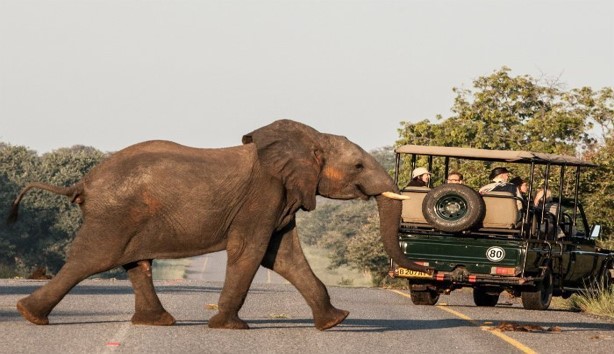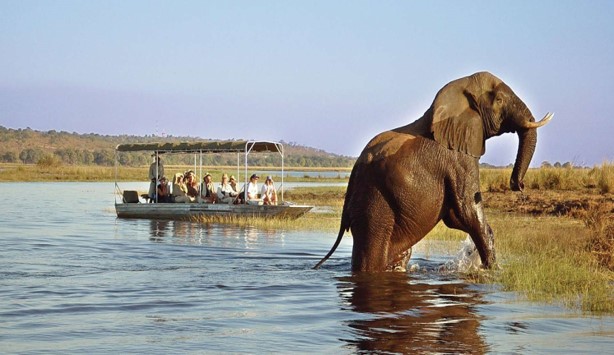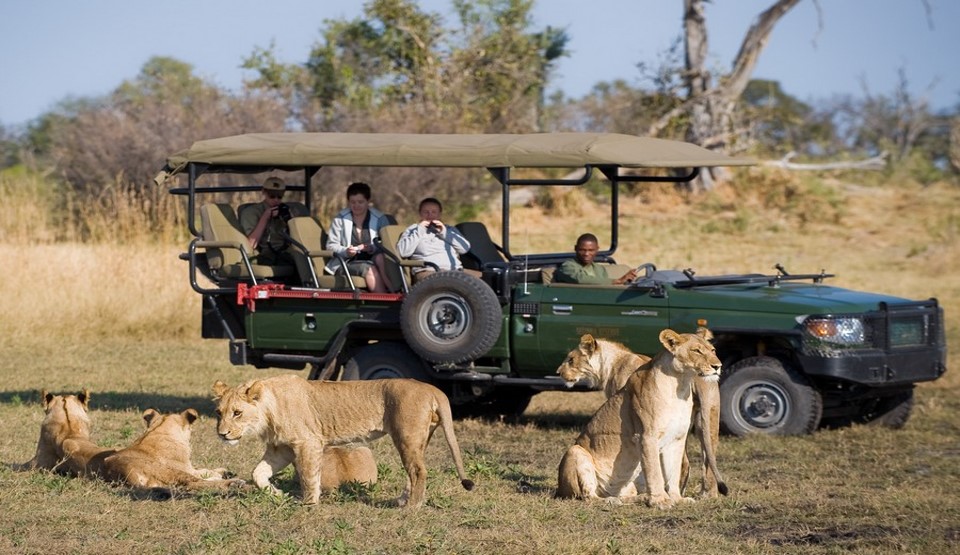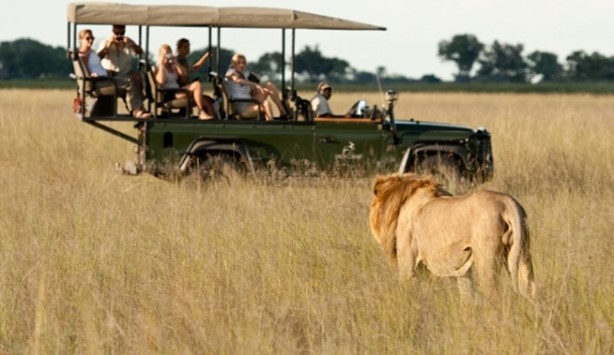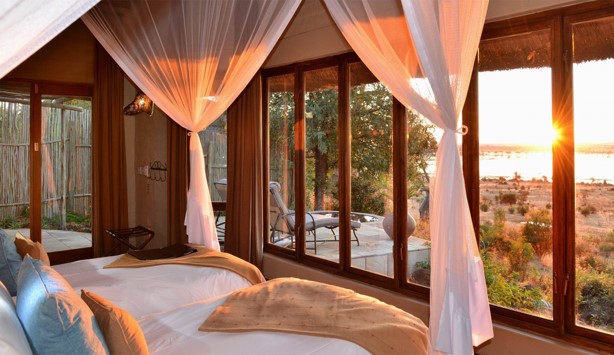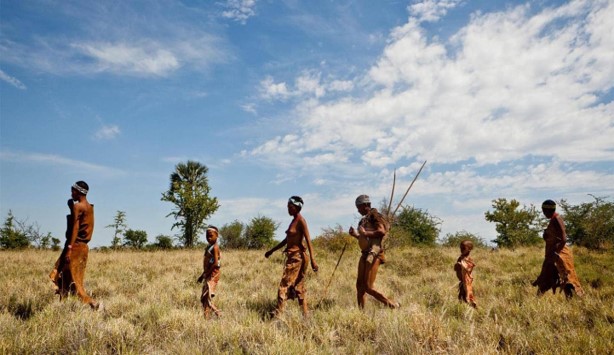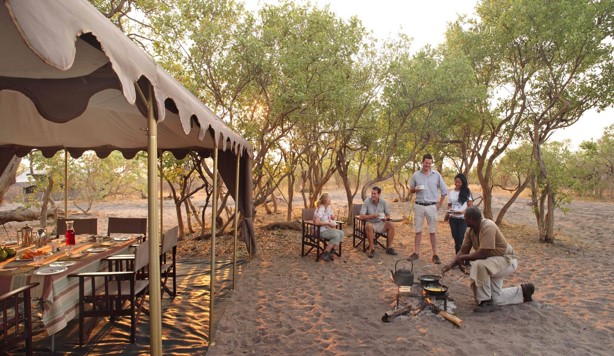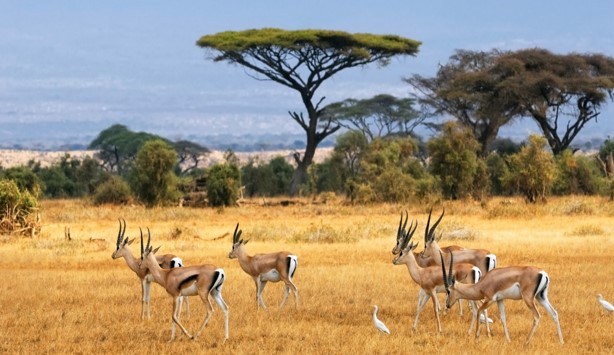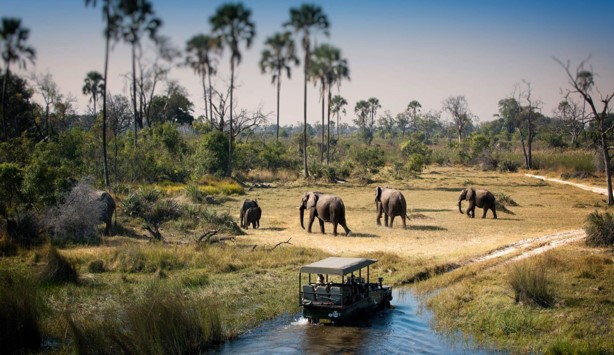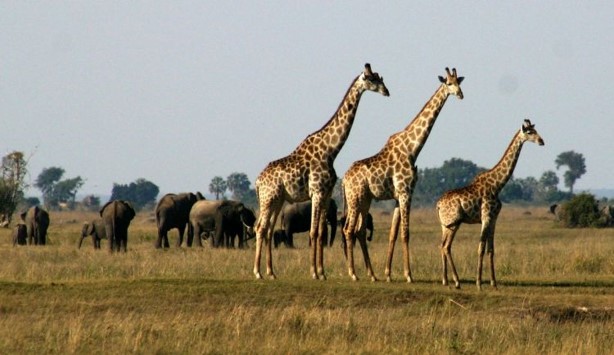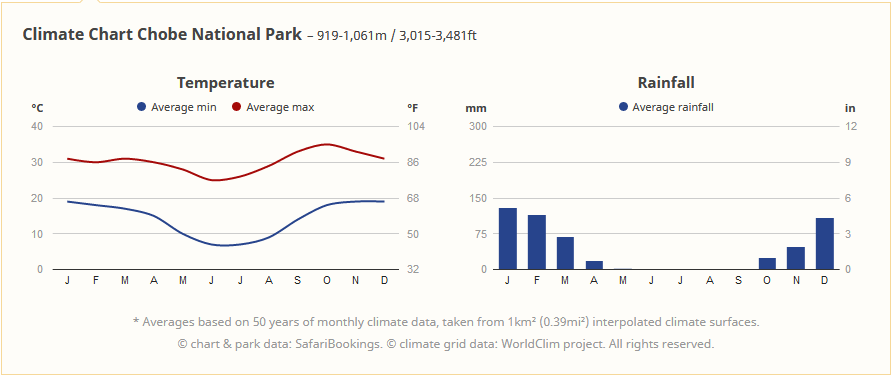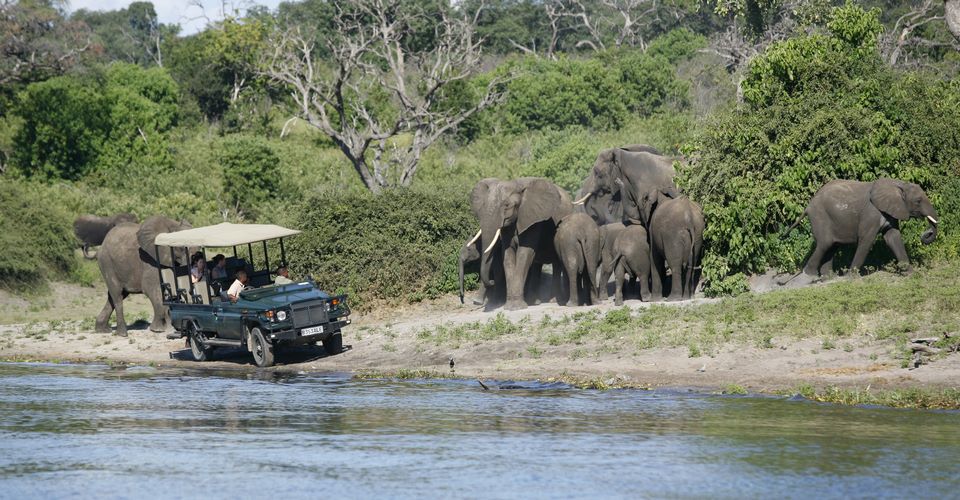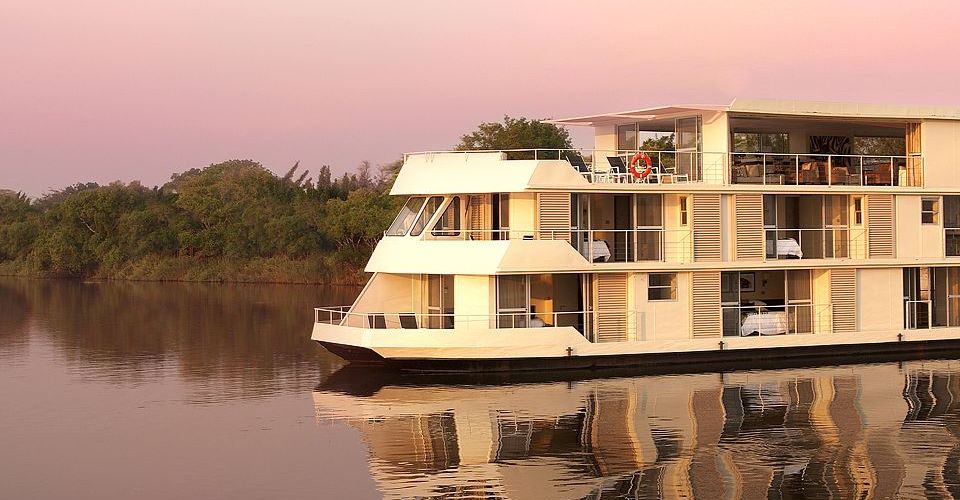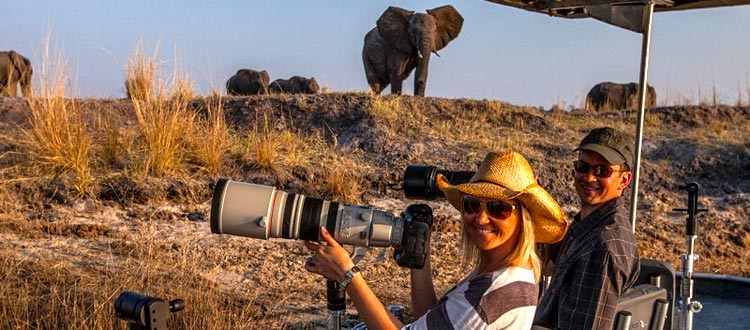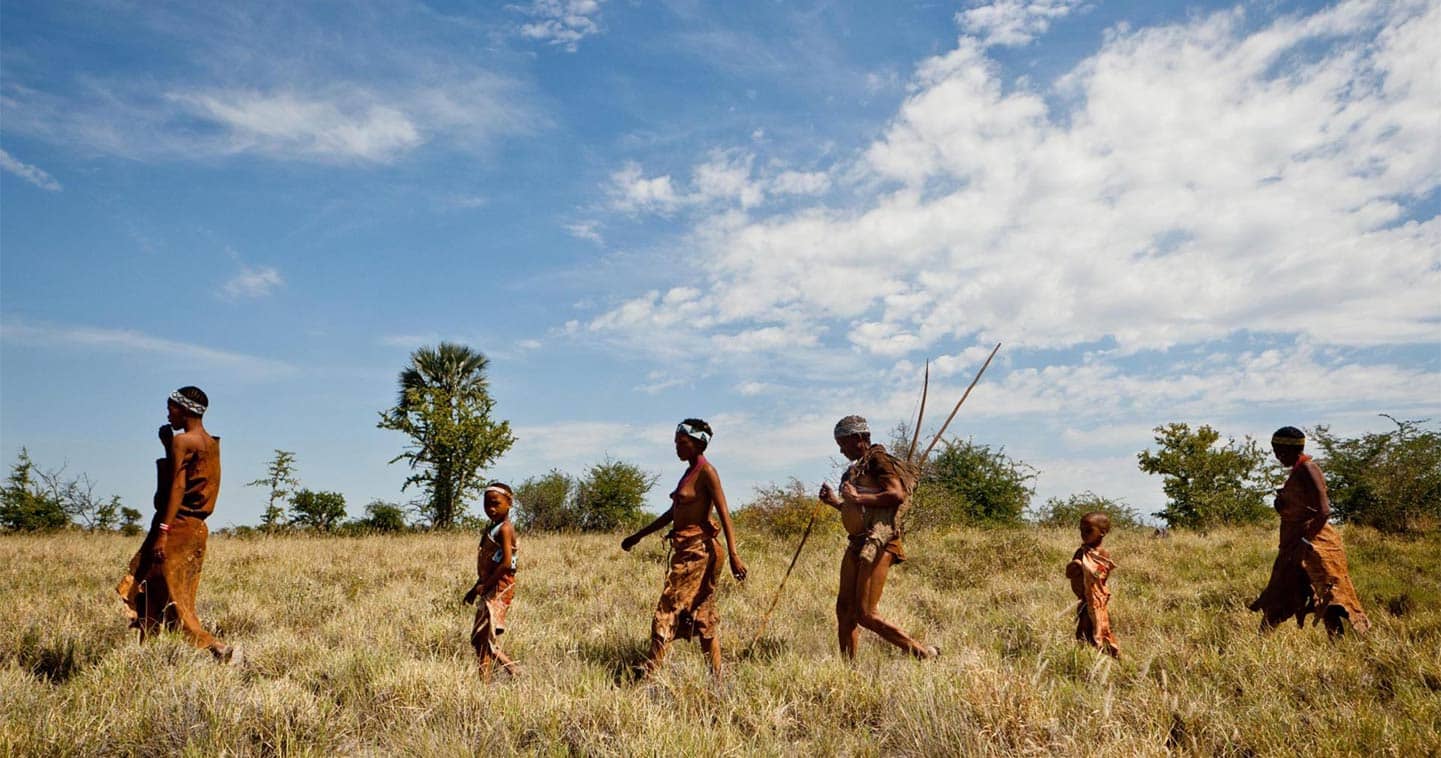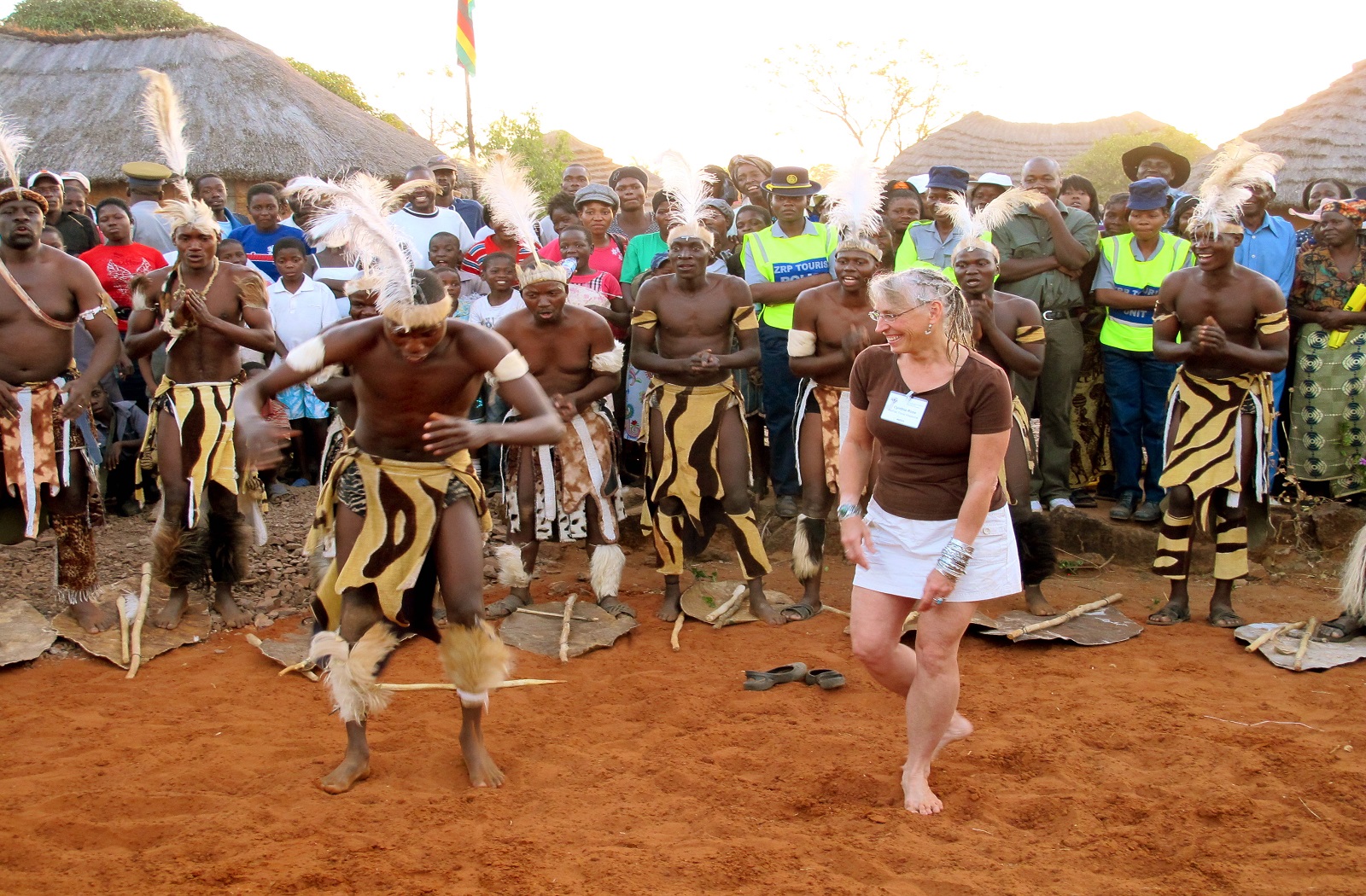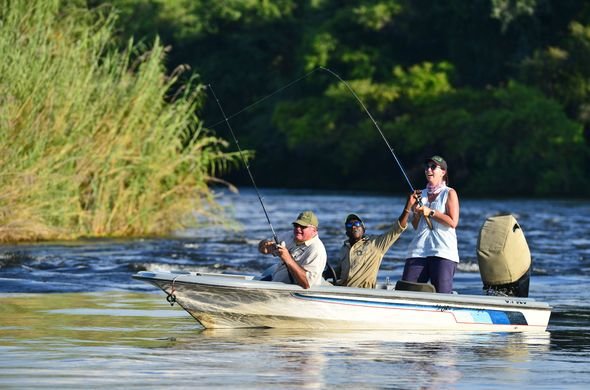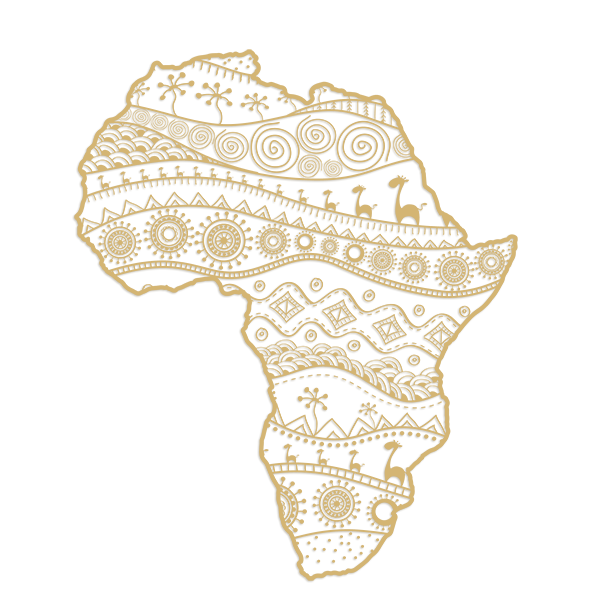
Chobe National Park
Country: Botswana

About Chobe National Park
Welcome to one of the great wildlife destinations of Africa
When you visit the Chobe National Park, you will never forget the first glimpse of the dazzling, deep blue Chobe River, as it winds its way through sandy terrain, small towns, lush floodplains, dense forests of cathedral mopane trees, and endless broadleaf woodlands. The park is named after this majestic river that protects 10.700 km² of the northern Kalahari desert, providing ensuing wilderness and a game density that is steadily remarkable.
A place for everyone – Chobe National Park
Famed for its massive elephant populations, big herds of buffalo (matched only by some large lion prides) and incredible birdlife, Chobe National Park will leave an everlasting memory. Where else can you find such an amazing riverfront, with bustling wildlife, undisturbed predators, heavenly landscapes and tranquil lodges? The most accessible area of the park is the Chobe Riverfront, this is also where you will find the largest concentration of wildlife. For a more predator-rich area: head off to Linyanti Marshes. Or nourish your soul in the remote Savuti area. Wherever you go in this park, wildlife encounters are plentiful and all of Chobe feels like true wilderness. It is a place that can be enjoyed by everyone: couples, families and seasoned Africa travelers.
We will explain more about the different areas below. But first, a little bit about the history of this special place.
History of Chobe National Park
The original inhabitants of Chobe were the Bushmen, followed by the – impressively named – Hambukushu, Bayei and Basubiya. In the 1850s, locals saw explorer David Livingstone passing through the area on his way to the Victoria Falls (a little over an hour away from Chobe National Park), and some big-game hunters seeking trophies and ivory. Luckily, for all the flora and fauna of this unique land, the area was first protected as a game reserve in 1961 and proclaimed as national park in 1968.
Up to this day the game-density remains exceptional. You will be forced to halt frequently because a parade of wildlife wants to pass by. Much better than stopping for a red light in traffic, right? Moderating the number of visitors to the park keeps it from feeling ‘too busy’, adding to the remote and exclusive Chobe safari experience.
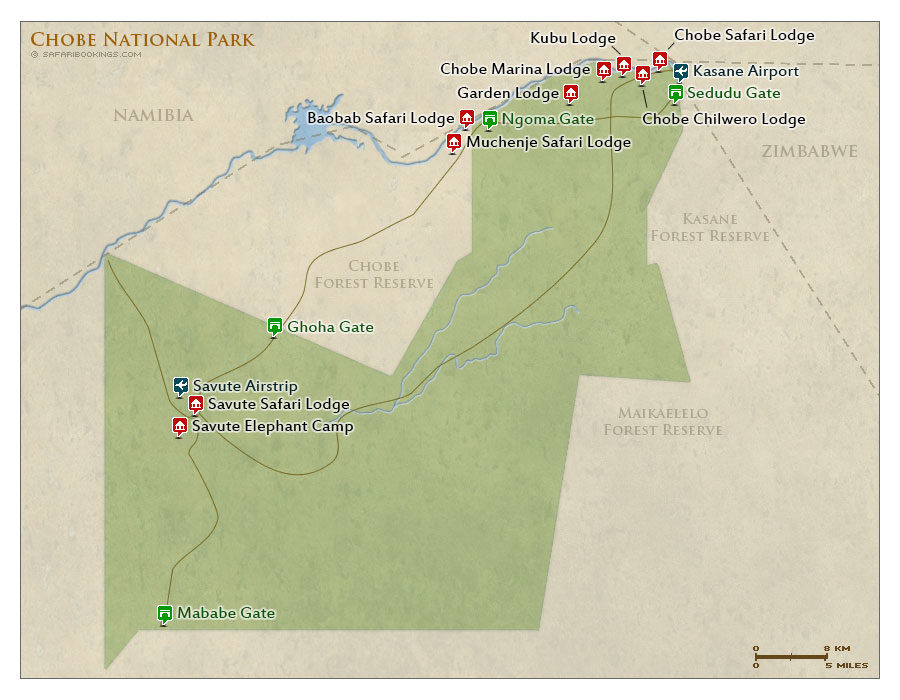
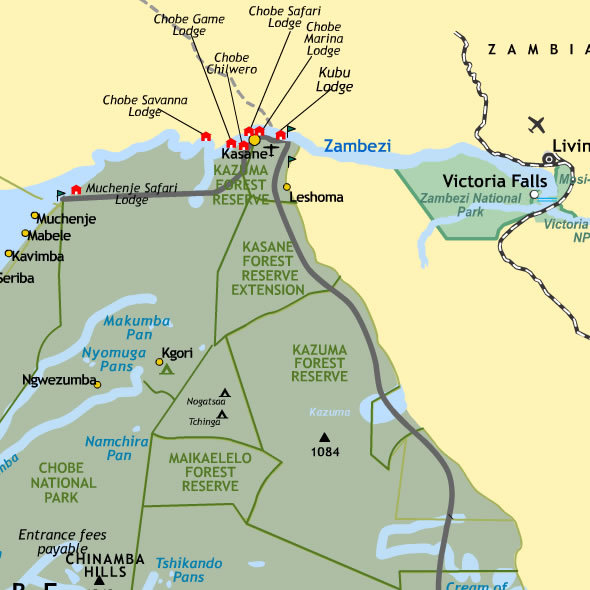
Vital Information
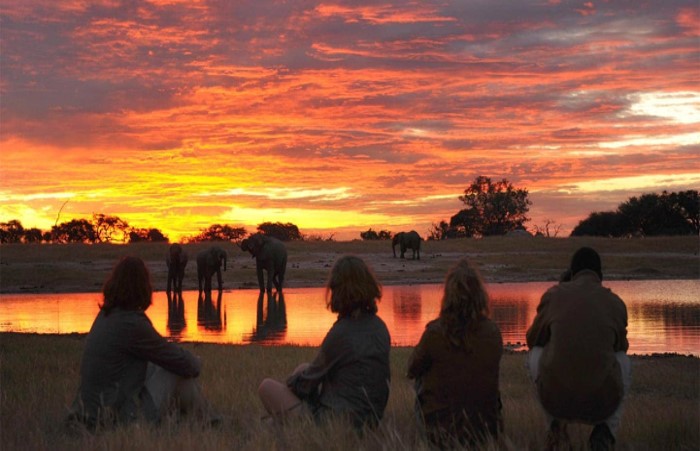
Activities
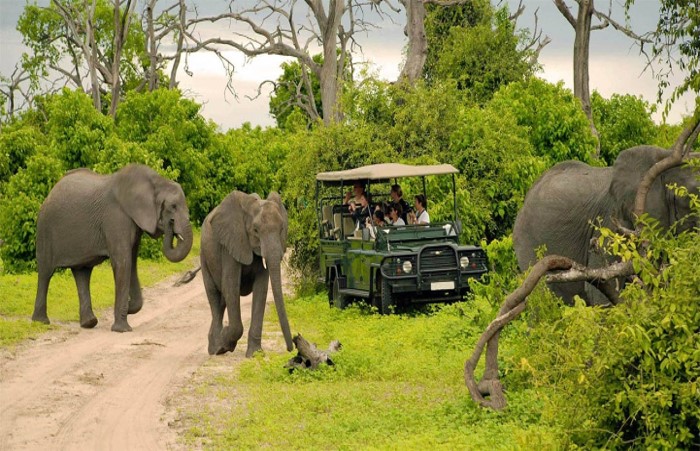
Chobe National Park Gates
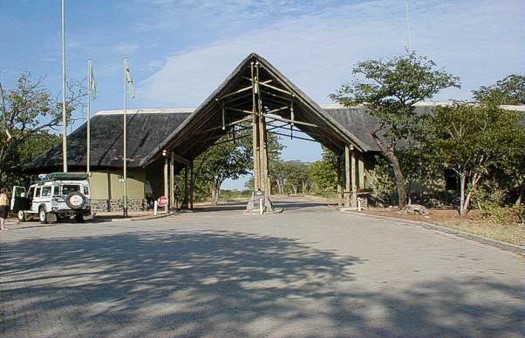
Vital Information
Weather & Climate – Chobe NP
Chobe has a warm to hot climate, and there is a Dry and Wet season. It is advisable to bring warm clothing for boat trips and morning drives.
Dry season –April to October
The last showers marking the end of the Wet season normally fall in April. From May, the park becomes drier and drier as the Dry season unfolds. June and July are the coolest months; however, temperatures begin increasing in August and peak in October, which is aptly named ‘suicide month’ by the locals.
- April & May – These months mark the beginning of the Dry season. The vegetation is still green, and it is mostly dry and sunny. It is hot in the middle of the day, with temperatures climbing up to 29°C/84°F.
- June, July & August – There is very little rain in these months. It is a bit cooler now with afternoon temperatures climbing up to about 27°C/80°F. Early mornings are cold at around 08°C/47°F.
- September & October – As the Dry season draws to a close, it continues to get hotter before the rains break. October is very hot with average afternoon temperatures of 35°C/95°F. However, conditions at night and in the mornings are agreeable.
Wet season –November to March
The first rains are a relief. It doesn’t usually rain all day, but thunderstorms in the afternoon and short showers are common. It’s hot throughout the season with afternoon temperatures of around 31°C/88°F. Mornings are pleasant, although it starts to cool down at night in March.
- November & December – Conditions are hot and sunny. Temperatures tend to build before it rains, and then drop afterward. Early mornings are pleasant – temperatures average about 19°C/65°F.
- January & February – The first two months of the year are the wettest. There is usually rain in the afternoon, but only for a few hours. Heavy storms are a regular occurrence.
- March – The rains are lessening. There is still rainfall every couple of days though, and it mostly comes as a thunderstorm. Mornings are cooler at 17°C/63°F.
How to get to Chobe National Park
Travelling to Chobe National Park
Chobe National Park is accessible in a variety of ways. And although your destination will feel far from the modern world, the reserve is easily accessible by plane. Most people choose a scheduled flight to get to Chobe National Park. Travellers on a longer journey travelling by rental car also have easy access to Chobe National Park.
A few flight possibilities are available for those who want to fly to Chobe National Park. South African Airways offers flights to some airports in the vicinity of the reserve. From OR Tambo Johannesburg International Airport in South Arfrica it is possible to travel to Kasane Airport (BBK), Livingstone Airport (LVI) in Zambia and Victoria Falls Airport (VFA) in Zimbabwe. Another possibility is to travel from Botswana’s capital city Gabarone to Kaanse. From all airports it is possible to continue the journey to your Chobe safari lodge by road transfer. We recommend flying directly from Johannesburg to Kasane, as this is the nearest airport and is serviced daily. The road transfer from Kasanse Airport to your destination lodge depends on the accommodation location.
Get ready for takeoff: lodge hopping
The most exciting start of a Chobe safari, is by arriving at your lodge with a so called ‘lodge hop’. This is an air transfer made by means of a small aircraft. These short charter flights can be arranged from Kasane Airport, Livingstone Airport and Victoria Falls. Most lodges located in Chobe National Park have an aistrip close to the lodge. With a lodge hop, your safari adventure will have an unforgettable takeoff. Flights are very scenic, as small aircrafts stay at a low altitude. Look out of the small window for an overview of the wonderful Chobe National Park. Please note that lodge hops are not required for lodges located in Kasane or on the Chobe Waterfront.
Chobe National Park is accessible when travelling by (rental) vehicle. A 4×4 vehicle is required.
Park Entry Fees.
| (Per person per day) | CITIZEN | RESIDENT | NON RESIDENT |
| Adults (18 and above) | P10.00 | P30.00 | P120.00 |
| Children (8 – 17 years) | P5.00 | P15.00 | P60.00 |
| Children under eight years | FREE | FREE | FREE |
| Vehicle fees Daily | Botswana Registered. | Foreign Registered. | |
| Motor Vehicles Under 3500 kg (Private) | P10.00 | P50.00 | |
| Motor Vehicles 3500kg – 7000 kg (Private) | P500.00 | P1,000.00 | |
| Motor Vehicles Over 7000kg (Private) | P800.00 | P1,500.00 |
Chobe River Front Campsite.
Ihaha Campsite & Savuti Campsite
- Toilet and shower facilities.
- BBQ facilities.
- Designated Campsites.
- Unfenced.
- Park fees are payable in cash on arrival at Botswana Wildlife office.
- No entry without a reservation.
- All visitors will camp at the correct campsites.
- Noise is to be to a minimum at all times.
- No off-road driving.
- Exit the park at 11:00 am at the exit gate.
These rates include
- A litter-free campsite (cleaned and raked).
- There is a maximum of three vehicles per site.
- Anti-bacterial soap and toilet paper in the ablution blocks.
- Daily rubbish collection.
- 12% government tax.
- Usage of clean ablution blocks with hot & cold showers and flushing toilets.
The following is not allowed.
• Generators
• Radio’s (Playing music)
• Sharing of sites
• Feeding animals
• Moving between the sites at night
Tipping in Botswana
Our travellers often ask, ‘How, who and how much should we tip on safari in Botswana?’ To help you to avoid awkward situations, below is some guidance on tipping in Botswana, the issues involved and the etiquette of doing so.
The local economy in Botswana: issues around tipping
As is common almost the world over, tipping in Botswana is always voluntary, and should depend on the quality of service received. It’s never compulsory, but we’d encourage visitors to tip to appreciate good service, while remaining mindful of the impact of this on the community.
Tipping can be a significant component of the income of those in service industries, including waiters, guides and trackers. Be aware, though, that there is a fine balance between tipping enough, and tipping too much. You may not think that tipping too much could cause problems, but it can: excessive tips can throw out the local economic balance.
For example, consider the job of a park ranger. Done properly, it’s an important job. A senior park ranger will need to be well-educated, knowledgeable, and will probably have had many years working for the government in various national parks. By local standards, the Botswana government will pay a fair wage for this job, but government employees are not usually top earners. However, having educated and competent people in this job is very important for the good of the parks, and the visitors who come to them.
By contrast, a camp hand who carries bags and helps out generally at a safari camp in Botswana, is also very necessary. However, s/he doesn’t need the same level of education, or experience, and doesn’t shoulder the same level of responsibility. If such a casual helper gets overly large tips – adding up to, say US$500 a month – there’s a danger that this job will end up paying more than a park ranger’s job.
In such a case, thus responsibility and remuneration will have become very unbalanced. Where’s the incentive for a ranger to put in more effort and take on more responsibility if he’ll be paid less than a camp hand? If unchecked, this could result in park rangers quitting their posts to become general camp hands, to the detriment of the park and its visitors.
So keep in mind the importance and extent of the work someone is doing for you, when you tip them.
Who to tip when on safari in Botswana
Before thinking about the amount or how to tip, think about who to tip. Many people work to make your travel a success. Consider:
- Tipping guides
Your safari guide will be one of the most important people in making your safari a success. With this in mind, many places suggest tipping him/her separately, to ensure that they get the tip they deserve.
- Tipping the back of house team
There are a lot of people who work behind the scenes to make your trip a success, including the chefs, the kitchen team, the maids and the housekeeping staff. To cover all of these ‘back of house’ people, many camps have a ‘general staff tip box’ – the proceeds of which are divided equally between the staff.
- Tipping the managers
We’re sometimes asked if travellers should tip camp managers. Of course they are important, but would you tip the owner of a restaurant? Generally, we don’t think so: we wouldn’t usually recommend that you tip the manager.
- Of course, if they helped you with something outstanding or very extraordinary, you might find yourself making an exception to this rule.
Normally in Botswana you tip the guide separately, as you’ll spend most of the time with them, and the rest of the staff together. It is unusual to tip a camp manager.
When to tip
We’re sometimes asked about when to give tips, and it’s an important question. The options are:
After each activity
At the end of each day
At the end of your stay
The answer is very clear: always tip just once, and always at the end of your stay at each safari lodge or camp.
Guides don’t expect a tip after each activity, and tipping this way would pressurise the guide to ‘perform’ for the guest who is tipping – whilst probably distorting the relationship between him/her and the guests as a whole. It would certainly put your fellow guests in a very difficult position if you were offering tips this frequently, and they were not.
How to tip
Most camps and safari lodges in Botswana have a ‘tip box’, and often their own tipping policy. Sometimes the ‘tip box’ will be for all the staff; sometimes it’ll be for the staff excluding the guides; occasionally it’ll be arranged differently.
Some camps explain their tipping policy in the literature left in their rooms. If not, ask the manager and, if there’s a tip box, find out who shares the proceeds of this. You can then decide whether to put everything into the box, or to tip some members of the team separately and more directly. In most Botswana camps, guides, trackers, mokoro polers and butlers are usually tipped directly; other staff are usually lumped together into the ‘general staff tip box’. But this varies, so do ask!
Travellers often ask if they can tip by credit card – and the answer depends entirely on the camp, their accounting practices and their ability to process cards. However, this isn’t the norm, and it makes it difficult to direct your tip to precise team members. It’s much more common to tip with cash, with the preferred currency in Botswana being Botswana pula or, failing that, US dollars, South African rands, or even euros or GB pounds.
One excellent idea is for well-prepared guests to bring a small supply of envelopes with them, perhaps with a note inside on which a ‘thank you’ could be written. Towards the end of your stay, you can name the envelopes for the people or groups of people whom you wish to tip, put the appropriate cash tip into each, then either hand them out to individuals or put them into the general tip box.
How much to tip
Bear in mind that all we can offer here is guidance from our experience in Botswana. In the end, tipping depends on your personal opinion and your individual satisfaction – moderated by some understanding of the issues mentioned above.
Given that, we’d recommend that for good service, our travellers tip around:
- US$10 per guest per day for a group guide
- US$20 per guest per day for a private guide
- US$5 per guest per day for mokoro polers, trackers or a butler
- US$5 per guest per day for the general staff
To put these suggestions in perspective, bear in mind that the Gross National Income (GNI) is about US$17.84 per person per day in Botswana. This is a reflection of the average income of Botswana’s citizens.
In contrast, the equivalent GNI in the UK is about $US118.74; in the United State about $US150.58; in New Zealand about US$109.80; and in Germany about US$125.45.
Gifts as a tip?
If you’re returning to a camp, it is a lovely gesture to bring personalised gifts for the people there, for example for the guide or butler. This isn’t done commonly, but is always appreciated. Favourite items include pens and books – especially wildlife guides (eg: comprehensive and detailed field guides).
Tipping is a sensitive issue, but there is no need to feel embarrassed. It’s a normal part of a service industry in Botswana, as it is in restaurants in many countries. Just remember that relatively affluent visitors can have a big impact on the local economy: tipping does influence the economic and social balance – so keep that in mind when you tip the staff during your safari in Botswana.
Make sure you avoid drinking tap water in Botswana. In urban areas the water is chlorinated and local people may drink it, however we very strongly advise you drink bottled water at all times. Water outside of the urban areas is contaminated.
In short, no. The water in Botswana is not safe to drink. This means you must ensure that ice cubes, drinking water and even the water for brushing your teeth is bottled. Always double check water bottles when they are handed to you to ensure they are sealed. During your safari, bottled water is readily available.
When to visit the Chobe National Park
We would love to provide a simple ‘this is the best time to visit’, but there is no such thing when it comes to Botswana. The Chobe National Park changes dramatically with the seasons, making it a year-round destination. Feel free to come at any time to experience the wonder.
Visiting Chobe National Park is more than just crossing the Big Five off your list. It is the complete package: broad skies, amazing sunsets, constantly changing colours, a warm African breeze (and even warmer African hospitality), lily padded waterways and – of course – some of the best game viewing imaginable. This combined, is what will make your trip truly memorable.
Chobe National Park and the seasons
We can definitely help you determine what is the best time for you to go. Botswana has both wet and dry seasons. In Chobe National Park, you will find a wider variety of bird species during wet season. When it comes to game migration: during dry season most animals stay around the riverside. When wet season begins, the interior pans (Savuti) provide amazing game sights. Although this is worth visiting all year round, April, May and November are particularly good times.
Wet.. or dry?
Most travelers pick the dry season for a safari in Chobe National Park, as ever-increasing water independent animals stay around the Chobe River. During the hot months – August, September and October – there is some sensational game viewing, if you can stand the heat… The rainy season is definitely worth considering, especially for birdwatching. During the wet season, most accommodations have less visitors, so you are in for a very personal experience. Also, child policies can be more flexible in this period. Nevertheless, all camps in the Chobe National Park feel personal, intimate and are small-scale.
Here’s a little bit about both seasons.
Dry season:
- May to November
- Ideal for a first time Africa trip
- Nights in the Chobe are never below freezing and the days are seldom unbearably hot
- Note that in November the weather is variable: rain or shine, hot or cold
Wet season:
- Between December and April
- January and February are the rainiest months
- Spectacular skies can change within minutes from cloudy to sunny to cloudy again
- Showers are usually short and heavy, but there are days when the sky remains grey
- Waterproof clothing is necessary, but the rain doesn’t need to stop you from doing anything
Please note that in Africa the weather is harder to predict these days. But as long as you look at your trip as an holistic experience with all its aspects, you will fully enjoy it.
Money
There are ATMs in major towns. Credit cards are accepted in most top-end hotels, but lodges and tour operators require advance payment by bank transfer. Otherwise, bring US dollars in cash.
Credit cards can be used in ATMs displaying the appropriate sign, or to obtain cash advances over the counter in many banks – Visa and MasterCard are among the most widely recognised. Transaction fees can be prohibitive and usually apply per transaction rather than by the amount you’re withdrawing – take out as much as you can each time. Check also with your bank before leaving home to see if some banks have agreements with your home bank that work out cheaper than others.
You’ll find ATMs at all the main bank branches throughout Botswana, including in Gaborone, Maun, Francistown and Kasane, and this is undoubtedly the simplest (and safest) way to handle your money while travelling.
Cash
The unit of currency is the Botswanan pula (P). Pula means ‘blessings’ or ‘rain’, the latter of which is as precious as money in this largely desert country. Notes come in denominations of P10, P20, P50 and P100, and coins (thebe, or ‘shield’) are in denominations of 5t, 10t, 25t, 50t, P1, P2 and P5.
Most common foreign currencies can be exchanged, but not every branch of every bank will do so. Therefore it’s best to stick to US dollars, euros, UK pounds and South African rand, which are all easy to change.
Foreign currency, typically US dollars, is also accepted by a number of midrange and top-end hotels, lodges and tour operators. South African rand can also be used on Botswanan combis (minibuses) and buses going to/from South Africa, and to pay for Botswanan vehicle taxes at South Africa–Botswana borders.
Most banks and foreign-exchange offices won’t touch Zambian kwacha and (sometimes) Namibian dollars; in border areas you can sometimes pay at some businesses with the latter. To make sure you don’t get caught out, buy/sell these currencies at or near the respective borders.
There are five commercial banks in the country with branches in all the main towns and major villages. Although you will get less favourable rates at a bureau de change, they are a convenient option if the lines at the banks are particularly long.
There is no black market in Botswana. Anyone offering to exchange money on the street is doing so illegally and is probably setting you up for a scam, the exception being the guys who change pula for South African rand in front of South Africa–bound minibuses – locals use their services, so they can be trusted.
For current exchange rates, log on to www.xe.com.
Changing Money at the Border
A word of warning: if you’re changing money at or near border crossings and not doing so through the banks, be aware that local businesses (sometimes bureaux de change, sometimes just shops with a sideline in currencies so that arriving travellers can pay their customs duties) usually have abysmal rates. Change the minimum that you’re likely to need and change the rest at a bank or bureau de change in the nearest large town.
Credit & Debit Cards
All major credit cards, especially Visa and MasterCard, but also American Express and Diners Club, are widely accepted in most shops, restaurants and hotels (but only in some petrol stations).
Major branches of Barclays Bank and Standard Chartered Bank also deal with cash advances over the counter and don’t charge commissions for Visa and MasterCard. Almost every town has at least one branch of Barclays and/or Standard Chartered that offers foreign-exchange facilities, but not all have the authority or technology for cash advances.
Exchange Rates
| Australia | A$1 | P8.03 |
| Canada | C$1 | P7.83 |
| Europe | €1 | P11.62 |
| Japan | ¥100 | P10.05 |
| New Zealand | NZ$1 | P7.67 |
| South Africa | R1 | P0.77 |
| UK | £1 | P13.05 |
| US | US$1 | P10.47 |
For current exchange rates, see www.xe.com.
Tipping
While tipping isn’t obligatory, the government’s official policy of promoting upmarket tourism has raised expectations in many hotels and restaurants. A service charge may be added as a matter of course, in which case there’s no need to leave a tip. If there is no service charge and the service has been good, leave around 10%.
It is also a good idea to tip the men who watch your car in public car parks and the attendants at service stations who wash your windscreens. A tip of around P10 is appropriate.
Guides and drivers of safari vehicles will also expect a tip, especially if you’ve spent a number of days under their care.
Most safari companies suggest the following as a rule of thumb:
- guides/drivers – US$10 per person per day
- mokoro trackers and polers – US$5 each per person per day
- camp or lodge staff – US$10 per guest per day (usually placed in a communal box)
- transfer drivers and porters – US$3
Travellers Cheques
Travellers cheques can be cashed at most banks and exchange offices. American Express (Amex), Thomas Cook and Visa are the most widely accepted brands. Banks charge anywhere between 2% and 3% commission to change the cheques; Barclays usually offers the most efficient service and charges 2.5% commission for most brands.
As a general rule, it is preferable to buy travellers cheques in US dollars, euros or UK pounds. Get most of the cheques in largish denominations to save on per-cheque commissions.
You must take your passport with you when cashing cheques.
Activities
Chobe Game Drives
Chobe game drives are the number one activity to experience while visiting Kasane and the Chobe National Park.
Chobe Game Drives in a custom built 4×4 safari vehicles. These vehicles have open sides which offer exceptional views for the guests. Professional Safari guides will be leading the game drives in the Chobe Park. The local experience and knowledge provide a great insight to animals and their behavior.
We offer various options for guests looking for game drives. The standard game drive is a 3-hour drive departing in the early morning or late afternoon from Kasane. We then also offer half day and full day trips. A minimum of two people will confirm a game drive departure on an open safari vehicle.number of 2 people to book. While on the half day or full day trip we require a minimum of 4 people to confirm a drive.
A full day excursion is an excellent way to learn about the wildlife and birdlife in Chobe. You will have an opportunity to have a picnic style lunch in the park. The full day drive departs at 08:00 am and returns to Kasane at 6 p.m.
The half day excursion departs Kasane at 06:00 am and returns at 12 pm. The half day tour includes breakfast in the park. The local Botswana safari guides are trained and extremely knowledgeable about the area. They are eager to share their knowledge of the animals and the birds and the history of the park.
You can join an existing scheduled departure or book a specialized trip on request. Bird watchers and photographers are welcome to contact us and schedule a private guided safari in Chobe National Park.
You are welcome to do multi-day game drives. The Chobe National Park offers a variety of animals and birds.
No two days are the same.
Chobe Game Drives Highlights.
- Open Game Drive Vehicles.
- Excellent Photographic opportunities.
- Magnificent Wildlife sightings.
- Spectacular views are seen from the Chobe River.
INCLUDES
- pick up and drop off from your accommodation in Kasane.
- 3 hour game drive – any time between 6 am until 3 pm
- Half day game drive – 6 am until 12 noon and includes breakfast
- full day game drive – 8 am until 6 pm and includes lunch
- Private game drive – pay for a minimum of 6 people, and then the normal per person rate applies for more than 6 people.
EXCLUDES
- Park fees – currently USD 10 pp
Chobe is particularly famous for its sunset boat cruises, a special favourite for birders and photographers which also gives you the perfect setting for a nice, cold sundowner or two. It’s the best way to see large herds of elephants crossing the river too, as well as the river’s sizeable hippo and crocodile population.
For both the budding amateur and the seasoned pro, Pangolin Photographic Safaris gears your Chobe experience around spectacular wildlife photo opportunities and provides the means by which to maximise those opportunities. Every client is provided with state of the art cameras and lenses and guided by seasoned photographers in custom-designed boats and vehicles.
There is no better way to get up close and personal with the African bush than on a guided bush walk. A small handful of lodges offer this unique and intimate activity in the picturesque Chobe Forest Reserve enclave of the national park. This is wild Africa at its most unadulterated.
For those seeking a rare insight into the interesting cultural heritage of the region, this activity takes you across the Chobe River by wooden makoro canoe and then on foot into a handful of traditional tribal villages located on the Namibian side of the bank.
The Chobe is blessed with an abundance of fish and is a very popular fishing destination. A number of operators and lodges can organize leisurely fishing trips and provide equipment and an experienced guide. This is a great place to catch the legendary Tigerfish as well as several species of bream, all of which are great on the braai.
Chobe National Park Gates
Park Fees and Entrance Gates
For 2015, park fees (per person) for Chobe National Park are as follows:
NON RESIDENTS: BWP 70.00
BOTSWANA CITIZENS: BWP 10.00
RESIDENTS: BWP 30.00
There are a numbe of different gates where you can pay your park fees and enter the park. The main entrance is at Sedudu Gate in the north-east of the park near the town of Kasane. Then there is Ngoma gate near Namibia, which can be accessed by the public road that runs for 54 kilometres through the park and is used by visitors from Namibia and thos stating in the Chobe Enclave. The southern entrance to the park is at Mababe gate along a route that connects with Moremi Game Reserve. This gate is 56km south of Saute.
